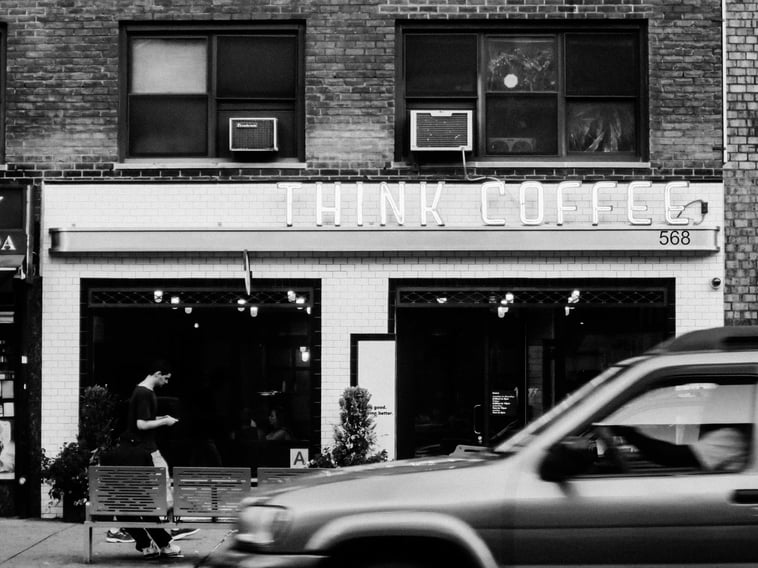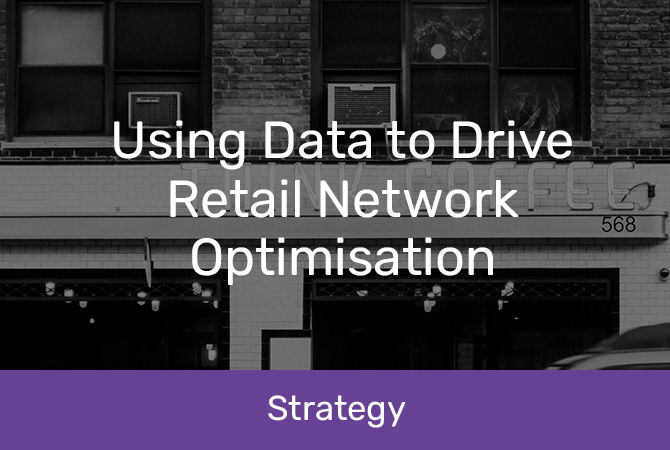
Using Data to Drive Retail Network Optimisation
considering RETAIL expansion or retraction? let data drive your decision-making
The world of brick-and-mortar retail is all about balance. Open too few stores, and you risk losing potential customers and vital sales. Too many shops, and your running costs start to outstrip revenue.
The problem? Retail store optimisation isn’t quite as simple as it seems.
If your business is thriving in one spot, it’s natural to imagine that a new location will perform just as well. So why not open a second, third or 35th store and pull in more profits? Opening a new place comes with challenges – competition, cannibalisation, market limits, and thousands or even millions in setup costs.
On the other hand, if one location is underperforming, closing down seems like the obvious choice. Again, it’s not always that straightforward – you need to know exactly how a shutdown will affect the rest of your network and your bottom line.
Getting it right is vital – particularly in today’s precarious economic climate. Before you even think about shiny new storefronts or demolition, you need to understand what you’re getting into.
And that’s where Datamine comes in.
 retail expansion - Costs, challenges and risk factors
retail expansion - Costs, challenges and risk factors
Opening a new location comes with some obvious downsides. Cost is a big one – buying or renting an existing space, renovating it to suit your needs, and buying furniture and fittings add up very quickly. If you have to build a new store, that goes double. Runaway inflation and rapidly rising building costs don’t help.
Less obvious is the risk involved with the location itself. You can cost the price of a build or renovation, but it’s less straightforward to work out how a new site will perform once it’s up and running. Demographics, competition, and even micro-location effects can all make a difference.
Different demographics, different results
Imagine you own a high-end gift store in a ritzy Auckland suburb. Your shop is flourishing, drawing in plenty of customers and turning a good profit most days. It’s natural to think that another location in a different suburb would deliver similar results. But that’s only sometimes the case. Demographic differences between suburbs – even those in the same city – can be stark. People in suburb A might have significantly more disposable income than those in suburb B. Also, your product lines and pricing may not appeal to people in a different income bracket.
Facing the competition
Competition is always an issue in business, and new locations can bring it into sharp relief. Remember the gift shop? If it was the only shop of its kind in its original location, that could be a significant part of its success. Opening in a new place means competing with a new range of stores – potentially with similar products – which can impact profitability. Competition can come from other gift shops, nearby malls and department stores, or florists and chemists that stock gift products.
Plus, opening in a new spot makes you a newcomer. It takes time to build loyalty in a new place, and if potential customers already have stores they know and like, it’s harder to break into that market.
Cannibalising your profits
Competition with other businesses is one thing – but what if you compete with yourself? Building a new location, particularly within a city or small area, runs the risk of moving revenue from one spot to another rather than increasing overall profitability. Build too close to your existing location, and your customers might simply switch between the two. Of course, the risk of cannibalisation also comes down to the market size. Depending on your product, there may be a natural ceiling for sales, making it hard to sustain a second or third location. For example, if you run a speciality game store in a small city, you may be getting all the sales you can from your audience. Moving into eCommerce or expanding into a new city could make more sense.
Macro vs Micro-location
The location of a new store needs to be considered on a few levels. Macro location is about the suburb or city, the demographics of the people in the area, and factors like the distance from your distribution centre or other places. Micro location is about the environment directly around your store. Is there enough parking nearby? Will you be part of a string of stores or surrounded by residential housing? What are your neighbours like? Is there any foot traffic in the area? These factors may not be obvious, but they can make all the difference in long-term success.
 retail Retraction - Costs, challenges and risk factors
retail Retraction - Costs, challenges and risk factors
It’s easy to tell when one store is underperforming in terms of sales numbers – but not so easy to predict what will happen when the store closes. In some cases, you may also have stores flying under the radar, matching sales for other locations but failing to deliver the sales numbers you would expect for their specific location.
Deciding to stay open, close, move or remodel is tricky – you need all the information you can get before you make the call. Here’s what needs to be considered:
reverse cannibalisation
Cannibalisation happens when a new retail location eats into sales from an existing store. Reverse cannibalisation happens when those sales disappear entirely – to competitors in the same location, to online stores, or to different products.
When you’re scoping out a potential retraction, you need to understand how much of the revenue from the existing site will be absorbed by other stores in your network vs how much will be lost. Sometimes, it’s worth keeping a store open and trying other tactics to increase sales rather than losing that revenue stream.
customer impact
Every retail location has a customer base that will be impacted by a closure – the key is understanding the level of impact. What’s the profile of customers to the store? How many of them shop exclusively at that location, and how many shop at one or more other sites? Does the catchment area of the location overlap with other sites or competitors? For example, a retail location in a small town may bring in customers from a wider area who otherwise wouldn’t be able to shop at your store at all.
retract, refurb, reframe
Closure isn’t the only option for an underperforming site. If you’re reluctant to lose the revenue and customer base associated with a location, consider refurbishing the store or changing its function to attract more or different customers. A standard retail location could become your end-of-line or outlet store, making it more appealing to bargain-hunting customers. Of course, refurbishing or adapting a store also comes with costs, so it’s crucial to model the impact of a change before you make a decision.
 Data is the answer
Data is the answer
We’ve said it before, and we’ll say it again: data is here to save the day. While most retailers are comfortable using browsing and CRM data to inform their marketing and online sales activities, using data to make real-world brick-and-mortar decisions is just as effective.
Data from a wide range of sources makes it possible to model the risks, benefits and potential profitability of new store locations or closures with a high degree of accuracy. With that information in hand, it’s far more straightforward to scope out potential locations, weigh up refurbishment options, or even assess the performance of your existing retail network. Instead of going by guesswork and feeling, you can make informed decisions about your optimisation choices.
Here’s how it works:
Turning raw data into real insights
Datamine’s Site Spotter is designed for retail optimisation. The tool aggregates, analyses and models data from various sources – fed by our powerful Business Insights tool – to give retailers confidence about location decisions. Data comes from your sales and CRM, online browsing tagged to location, and public demographic and competitor information.
The tool doesn’t just collect and display data – it models likely outcomes and presents them in an accessible, actionable way. Data can be shown on a map of potential locations, with critical statistics linked to each. Instead of poring over spreadsheets, you get a clickable, digestible snapshot of each site. For example, in location A, you’re likely to bring in a profit of $10,000 per month, while location B is more likely to bring in $20,000. On the other hand, location A might cannibalise 10% of the business from your original store, while location B could take 40%.
Moving forward with confidence
There’s no single way to use Site Spotter and location analytics. It’s about using the data to get the answers you need, whether that means investing in a new location or closing one or more existing stores.
You can also use the tech to assess the state of your current retail network. If you have ten stores in a relatively small catchment area, are they all performing at a similar level, or are some stores weaker? Are some locations cannibalising others and not bringing in new business? Are there gaps where a new store could make a difference or locations that seem to be losing money?
By looking at your overall network rather than assessing stores in isolation, you can drill down into the factors driving your success – or contributing to ongoing issues.
expansion support
If you’re considering expansion, the tech can be an effective digital location scout. The tool assesses a wide range of potential retail locations within a set area and breaks down the risks and rewards of each. It’s a way to speed up your expansion journey and narrow the possibilities early on.
You can also use Site Spotter to compare two similar location options you have already started investigating. For example, spaces in adjoining suburbs, with comparable rental costs and at an equal distance from your existing store. Site Spotter helps distinguish the differences between the two and expresses them in hard numbers – from likely profitability and cost breakdowns to potential cannibalisation. With that information, it’s easier for you to choose.
close with confidence
Closing a store is never fun, but it’s easier if you’re certain you’ve made the right decision. Despite being called ‘Site Spotter’, our optimisation tools can also assess potential closures as well. Using long-term sales data and customer information, it can model the likely outcome of a store closure in terms of revenue and customer loss. It can also help you investigate other options, such as refurbishment, to determine whether the costs will be offset by increased revenue.
 Case study: Torpedo 7 new retail stores
Case study: Torpedo 7 new retail stores
When New Zealand-based sporting and adventure retailer, Torpedo7, wanted to expand its retail network in Auckland, it came to Datamine for help. It didn’t have a particular location in mind but wanted to assess a range of sites across the supercity to determine its next steps.
Using Site Spotter, we combined historical sales data from its existing network, customer spending data from our retail tracking tech, and census information to model new site builds in every Auckland region. The Torpedo7 team received an interactive map that broke down likely outcomes for each hypothetical new store, including key metrics like total sales, network uplift and cannibalisation. The data helped the team understand their options within the Auckland market and identify the most promising locations for new sites.
 Better data analytics, better decision-making
Better data analytics, better decision-making
Business decisions can be fraught – especially when it comes to retraction and expansion. Balancing costs and rewards, factors like competition and cannibalisation, and picking potential locations can all be complex, particularly if you’re doing it alone.
Datamine’s Site Spotter tool takes the guesswork out of location optimisation, giving you the numbers you need to make robust decisions. With a wide variety of data sources, complex modelling and analytics, Site Spotter isn’t instantaneous – it can take two weeks to assess a single store and even longer to model outcomes for an entire retail network. But the benefits are significant: maximising the profitability of your sites, reducing risks and boosting confidence for you and other stakeholders before a big move. You might even choose to delay or cancel a project after seeing the analysis results – it’s about having all the information you need to make the right decision.
Imagine spending millions on a shiny new store only to close a year later, or closing stores and losing a valuable chunk of your audience. Instead of making rash decisions, it’s far better to run the numbers first, eliminate those high-risk options, and know that you’re making the right decision for your business.
Ready to start your expansion journey? Talk to the team at Datamine to get started.
At Datamine, we work with clients across Australia and New Zealand in almost every sector – from retail and banking to not-for-profits.


















.jpg)







-1.jpg)






















